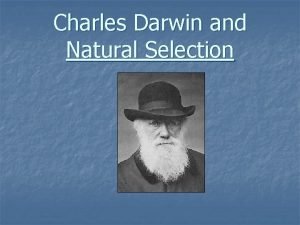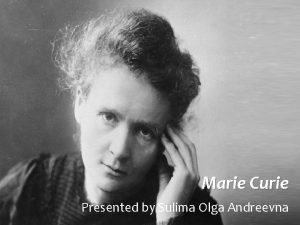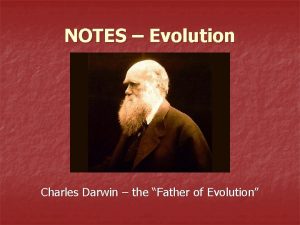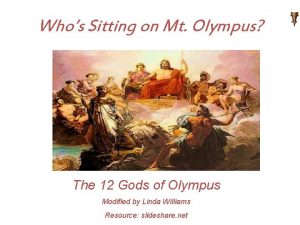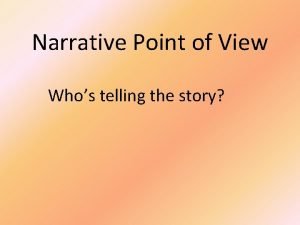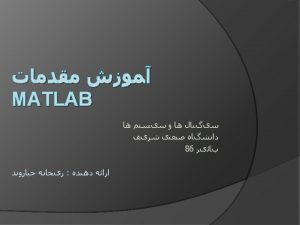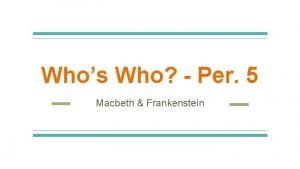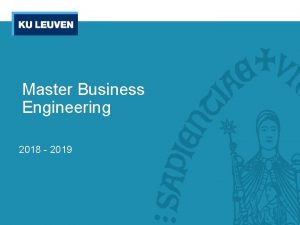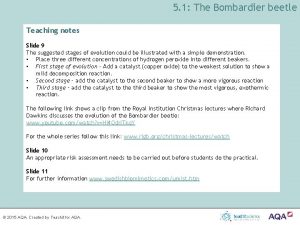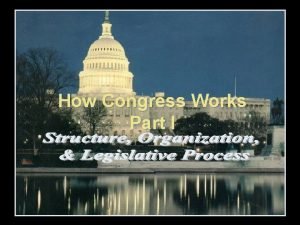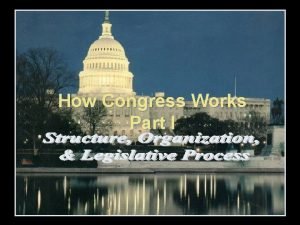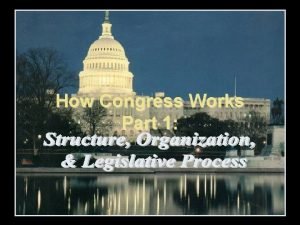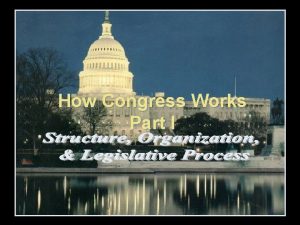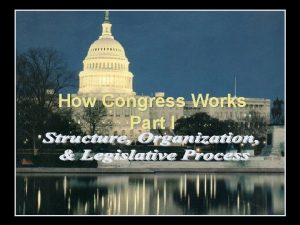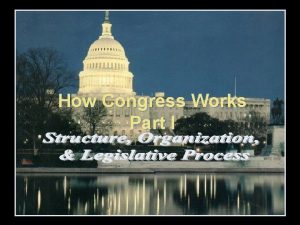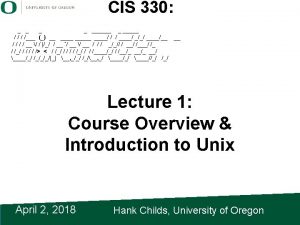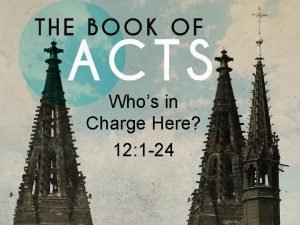How Congress Works Part I Whos in Congress





































- Slides: 37

How Congress Works Part I

Who’s in Congress?

What are the factors that influence how a member of Congress Vote on Legislation? n n n Personal Beliefs Constituent Interests Interest Groups n n - Political Action Committees (PACs) Political Party Loyalty

Functions of Congress 1. Lawmaking - make binding rules for all Americans (federal budget, health-care reform, gun control). The majority of bill originate in the executive. 2. Representation - elected officials who represent the views of their constituents. A. Trustee View - legislator who acts according to his or her conscience and the broad interests of the entire society. B. Instructed-Delegate View - legislator is an agent of the voters who elected them, regardless of personal belief.

Functions of Congress 3. 4. 5. 6. Constituency Service - legislators are expected by their constituents to act as brokers between private citizens and the imposing federal government. This takes the form of casework. Oversight - process by which Congress follows up on the laws it has enacted to ensure that they are enforced and administered the way Congress intended. Public Education - public hearings, oversight of the executive, committee debate, etc. (Agenda-setting) Conflict-Resolution - resolve conflicts within American society. Interest groups and other organizations count on Congress to address their grievances. Resolve competing viewpoints.

How are We represented?

Bicameral Two Houses Senate and the House of Representatives • Two house system allows each house to ‘check’ the actions of the other and helps prevent Congress from passing laws in a hurry.

Virginia Plan New Jersey Plan Connecticut Compromise

Demographic Profile of the 112 th Congress Age Groups Gender Party Ethnicity Source: http: //www. congress. org/congressorg/directory/demographics. tt

• Since 1789, 12, 013 individuals have served in Congress: – 10, 737 in the House and 1, 930 in the Senate. – Six hundred and fifty-four of these Members have served in both chambers.

Party Breakdown n n In the 112 th Congress, the current party alignments are 241 Republicans in the House of Representatives, 198 Democrats including 2 vacant seats. The Senate has 51 Democrats; 2 Independents, who caucus with the Democrats; and 47 Republicans.

n n n n n n n 49 Senators have previous House service; 81 educators, employed as teachers, professors, instructors, fundraisers, counselors, administrators, or coaches (68 in the House, 13 in the Senate); 2 medical doctors in the Senate, plus 1 veterinarian and 1 ophthalmologist; 15 medical doctors in the House (including one delegate), plus 2 dentists, 1 veterinarian, 1 ophthalmologist, and 1 psychiatrist; 10 2 psychologists (both in the House), an optometrist (in the Senate), and 6 nurses (all in the House); 5 ordained ministers, all in the House 39 mayors (29 in the House, 10 in the Senate) 11 state governors (all in the Senate) and 9 lieutenant governors 10 judges (all in the House), and 26 prosecutors 1 cabinet secretary, 1 secretary of the navy, and one ambassador (all in the Senate); 263 state or territorial legislators (222 in the House, including 2 Delegates, and 41 in the Senate) 105 congressional staffers (21 in the Senate, 84 in the House), as well as 9 congressional pages 4 Peace Corps volunteers, all in the House 3 sheriffs and 2 deputy sheriffs, 2 FBI agents, a border patrol agent (all in the House), and a firefighter in the Senate 1 physicist, 1 chemist, 6 engineers, and 1 microbiologist (all in the House) 4 radio talk show hosts (two House, two Senate), 3 radio or television broadcasters (all in the House), 6 reporters or journalists (2 in the House, 4 in the Senate), a radio station manager, a public television producer, a sportswriter, and a television commentator (all in the House) 7 accountants in the House and 2 in the Senate 4 pilots, all in the House, including a former pilot of Marine One (the President’s helicopter), and 1 astronaut, in the Senate 2 screenwriters (1 House, 1 Senate), a comedian, in the Senate, a documentary film maker, also in the Senate, and 2 professional football players, both in the House 17 farmers (15 House, 2 Senate) and 11 ranchers (9 House, 2 Senate) 2 almond orchard owners, both in the House, 1 farm manager (a Senator), 1 cattle farm owner (a Senator), 1 vintner (a House Member), and 1 fruit orchard worker 7 social workers in the House and 2 in the Senate; and 5 current members of the military Reserves (3 House, 2 Senate), and 4 current members of the National Guard (3 House, 1 Senate).

n n n 49 Senators have previous House service; • 81 educators, employed as teachers, professors, instructors, fundraisers, counselors, administrators, or coaches (68 in the House, 13 in the Senate); • 2 medical doctors in the Senate, plus 1 veterinarian and 1 ophthalmologist; 15 medical doctors in the House (including one delegate), plus 2 dentists, 1 veterinarian, 1 ophthalmologist, and 1 psychiatrist; 10

House-Senate Differences House n n 435 members; 2 yr terms Low turnover All 435 elected every two years Scheduling/rules controlled by majority party with powerful Rules Committee (controls time of debate, amends. , etc) Senate n n 100 members; 6 yr terms 1/3 elected every two years Moderate turnover Scheduling/rules agreed to by majority & minority leaders

House-Senate Differences HOUSE SENATE 25 years 30 years U. S. Citizenship At least 7 years At least 9 years Length of term 2 years 6 years Minimum age Number per state Constituency Depends on population: 1 per 30, 000 in 1789 1 per 690, 000 today Tends to be local 2 per state Both local and national

House-Senate Differences n n n House Debate limited to 1 hour Emphasizes tax & revenue policy More formal & impersonal n n n Senate Unlimited debate unless cloture rule invoked Emphasizes foreign policy More informal & personal

House of Representatives n n Membership The number of Representatives each state can elect is based on the size of that state’s population. Each state has at least 1 Representative. 435 total Representatives. Every 10 years, after the census is taken, Congress determines how the seats in the House are to be apportioned, or distributed.

Party Leadership Bicameral Democratic Leadership Senate Republican Leadership 110 th Congress

HOUSE LEADERSHIP Speaker (majority party) Democrats: • Majority Leader • Majority Whip • Chairman of the Caucus • Steering & Policy Committee • Democratic Congressional Campaign Committee

HOUSE LEADERSHIP Republicans: • Minority Leader • Minority Whip • Chairman of Conference • Policy Committee • Committee on Committees • National Republican Congressional Committee • Research Committee


SENATE LEADERSHIP President of the Senate (Vice President) President Pro Tempore (majority party) Democrats: • Majority Leader • Majority Whip • Chairman of Conference • Policy Committee • Steering Committee • Democratic Senatorial Campaign Committee President of the Senate Joe Biden (D-DE) Majority Leader Harry Reid (D-NV)

SENATE LEADERSHIP Republicans: • Minority Leader • Minority Whip • Chairman of Conference • Policy Committee • Committee on Committees • Republican Senatorial Committee Minority Leader of the Senate Mitch Mc. Connell (R) Majority Whip of the Senate Dick Durbin (D)


How should members of Congress behave? Delegate Politico Trustee

CAUCUSES • Groups (may be bipartisan) meeting to pursue common legislative objectives • Rivals to parties in policy formulation • Examples: Democratic Study Group, Congressional Black Caucus, Tuesday Lunch Bunch, Human Rights, Congressional Caucus for Women’s Issues, Out of Iraq Caucus, Rural Caucus, Travel & Tourism Caucus, House Caucus on Missing and Exploited Children

"Congress in session is Congress on public exhibition, whilst Congress in its committee-rooms is Congress at work. ” - Woodrow Wilson

Legislative Committees: Function and Purpose

Legislative Committees: Function & Purpose 1. Consider bills (a. k. a. “mark-up” bills) A bill with a member’s mark-up notes

Legislative Committees: Function & Purpose 2. Maintain oversight of executive agencies Secretary Donald Rumsfeld testifies before a Senate Appropriations Committee hearing re: the Department of Defense Budget (May, 2006)

Legislative Committees: Function & Purpose 3. Conduct investigations New Orleans Mayor Ray Nagin testified before the Senate Homeland Security and Governmental Affairs Committee on Hurricane Katrina (Feb. , 2006

Types of Committees Ø Standing Committees - permanent panel with full legislative functions and oversight responsibilities • Subcommittees – formed to tackle very specific tasks within the jurisdiction of the full committees Ø Select or Special Committees - groups appointed for a limited purpose and limited duration Ø Joint Committees - includes members of both chambers to conduct studies or perform housekeeping tasks Ø Conference Committee - includes members of House & Senate to work out differences between similar bills

Standing Committees

House Standing Committees Agriculture Appropriations Armed Services Budget Education & Workforce Energy & Commerce Financial Services Government Reform House Admin. International Relations Judiciary Resources Rules Science Small Business Standards of Official Conduct Transportation & Infrastructure Veterans Affairs Ways & Means

Senate Standing Committees Agriculture, Nutrition, & Forestry Appropriations Armed Services Banking, Housing, & Urban Affairs Budget Commerce, Science, Transportation Energy & Natural Resources Environment and Public Works Finance Foreign Relations Governmental Affairs Health, Education, Labor & Pensions Judiciary Rules and Administration Small Business and Entrepreneurship Veterans Affairs

Special, Select Committees • House Select Committee on Energy Independence & Global Warming • Senate Select Committee on Ethics • House & Senate Select Committees on Intelligence Gen. Michael Hayden is sworn in during a full committee hearing of the Senate Select Intelligence Committee on his nomination to be director of the Central Intelligence Agency.

Joint Committees • Joint Economic Committee • Joint Committee on Printing • Joint Committee on Taxation hearing
 Safety at street works
Safety at street works Literary device in the lottery
Literary device in the lottery Whos adam smith
Whos adam smith Whos who ideas
Whos who ideas Whos darwin
Whos darwin Finding nemo journey map
Finding nemo journey map Whos your daddy chapter 25
Whos your daddy chapter 25 Whos the famous painter
Whos the famous painter Activity 1. who's who
Activity 1. who's who Whos marie curie
Whos marie curie Whos sitting bull
Whos sitting bull Button button whos got the button
Button button whos got the button Whos the father of evolution
Whos the father of evolution Animal farm chapter 1
Animal farm chapter 1 Whose child is this
Whose child is this Macbeth act 1 discussion questions and answers
Macbeth act 1 discussion questions and answers Animal farm
Animal farm Gods in olympus
Gods in olympus Whos telling the story
Whos telling the story Find the song
Find the song Hamlet character map
Hamlet character map Skodowska
Skodowska Whos here
Whos here How to clear matlab command window
How to clear matlab command window Whos this
Whos this Whos job is it
Whos job is it Frankenstein characters
Frankenstein characters Quiz od
Quiz od Where has macduff gone and why
Where has macduff gone and why The story of achilles heel
The story of achilles heel Ku leuven whos who
Ku leuven whos who Whos for the game jessie pope
Whos for the game jessie pope Whos job is it
Whos job is it Im watching tv
Im watching tv Whos entitled to 30 hours free childcare
Whos entitled to 30 hours free childcare Who wants
Who wants Whos charles darwin
Whos charles darwin Who is thane of glamis
Who is thane of glamis




